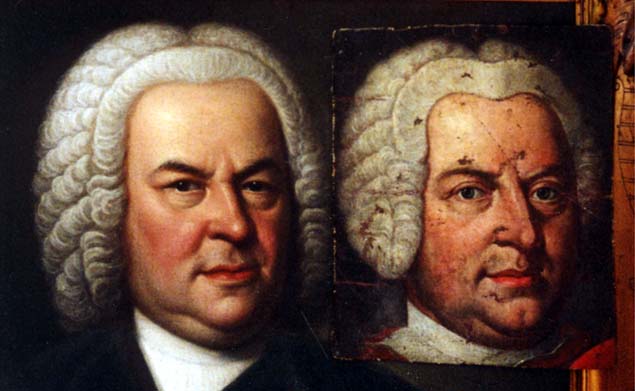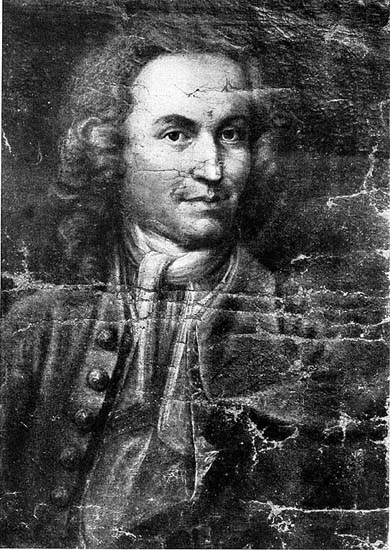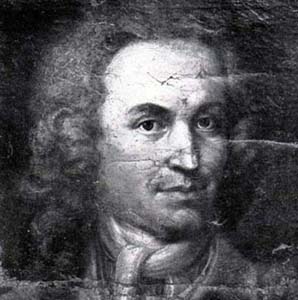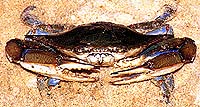The Portrait in Erfurt Alleged to Depict Bach, the Weimar Concertmeister - Is this young man really Johann Sebastian Bach? Pages
at The Face Of Bach
Page 6
The Face Of Bach
This remarkable photograph is not a computer generated composite; the original of the Weydenhammer Portrait Fragment, all that
remains of the portrait of Johann Sebastian Bach that belonged to his pupil Johann Christian Kittel, is resting gently on the surface
of the original of the 1748 Elias Gottlob Haussmann Portrait of Johann Sebastian Bach.

1748 Elias Gottlob Haussmann Portrait, Courtesy of William H. Scheide, Princeton, New Jersey
Weydenhammer Portrait Fragment, ca. 1733, Artist Unknown, Courtesy of the Weydenhammer Descendants
Photograph by Teri Noel Towe
©Teri Noel Towe, 2001, All Rights Reserved
The Portrait in Erfurt Alleged to Depict Bach, the Weimar Concertmeister


Before the 1907 Restoration and As It Looked in 1985
Is this young man really Johann Sebastian Bach?
Page 6
Those who are familiar with the Queens College Lecture know that the moment of reckoning now truly is at hand. They know that
the 1748 Haussmann Portrait, no matter how vehement and forceful Heinrich Besseler's rejection of it may have been, is the
reference image against which any and all aspirants to authentication as portraits from life of Johann Sebastian Bach must be
compared.
And so, let me put the Erfurt Portrait, in its unrestored state, through the same sequence of comparisons through which I have put
the Weydenhammer Portrait Fragment and the Volbach Portrait, and let's see how it fares. In the following series of comparisons,
the unrestored form of the Erfurt Portrait is on top or to the viewer's left, and the 1748 Haussmann Portrait is on the bottom or to
the viewer's right, as the case may be.
Starting from the top and working down:


There is a superficial similarity between the shape of the eyebrows, but, because there appears to be no sign of incipient ptosis or
blepharochalasis, it is dangerous to draw any conclusions from the apparent difference in the shape of the upper eyelids.
Next, the eyes themselves:


Even after making allowances for an age diference of more than thirty years and the effects of ptosis and blepharochalasis, it is
clear that these are not the same pair of eyes. The distinctive curve of the lower lid of Bach's right eye, as it meets the bridge of the
nose that is so plainly visible in the 1748 Haussmann Portrait (and in the Weydenhammer Portrait Fragment, the Berlin Portrait, and
the Volbach Portrait, too, for that matter!) is not at all in evidence in the Erfurt Portrait. Similarly, the upper right eyelid meets the
bridge of the nose in a manner that is distinctly different from the upper right lid in the 1748 Haussmann Portrait. Finally, please note
that the distinctive downward curve that outlines the bag beneath the right eye begins where Bach's right eye meets the nose in the
1748 Haussmann Portrait is not to be found in the Erfurt Portrait, in which the beginnings of the downward curve start at a point
beneath the junction of the eye and the nose. The subject of the Erfurt Portrait also does not appear to have been "wall eyed" in the
right eye, as Bach appears to be in both the 1748 Haussmann Portrait and the Weydenhammer Portrait Fragment.
Next, the nose itself. As we have seen, the nose of the Erfurt Portrait is one of the places where the restorer's "legerdemain" is most
egregious. For that reason, for this first comparison, which is designed to show how configuration of the restored nose was
determined, I have lined up in a row, the nose of the 1746 Haussmann Portrait as it looked after Schönfelder restored it, the nose of
the Bretikopf portrait, the Erfurt Portrait after the 1907 restoration, and finally the nose of the Kütner print. (Both the nose of the
Breitkopf Portrait and the nose of the Kütner print have been "flopped" to compensate for the "mirror image" aspects of the
originals, which themselves "flop" the 1748 Haussmann Portrait from which they are both ultimately derived. Clearly, in addition to
the 1746 Haussmann Portrait as it looked after Schönfelder restored it, which is the only portrait he specifically mentions in his
article, Dr. Overmann and his colleagues studied the Breitkopf portrait and the Kütner print very carefully when making the
decisions about how the abraded spots on the surface of the canvass would be in-painted. The shape of the left side of the nose
and the resulting profile of the nose, particularly the bulge or ridge that begins about one-third of the way down in the restored nose
of the Erfurt Portrait clearly owe a great deal to the Breitkopf portrait and the Kütner print and next to nothing to the 1746
Haussmann Portrait as it looked after Schönfelder restored it.




But does the unrestored nose of the Erfurt Portrait support such a restoration? It is not "open and shut", but, in all likelihood, the
decision of the 1907 restoration team owed much to wishful thinking:




It certainly is possible to argue that the shape of the nose as originally painted had that depression after the bulge, but when the
heads in their entirety are compared, that possibility seems much less of a probability. It is much more likely that the as yet
unidentified sitter for the Erfurt Portrait had a nose with a profile that was much more aquiline. In this context I cannot help but
recall the words of yet another treasured friend and mentor, Rosalyn Tureck, the "High Priestess of Bach" as one knoweldgeable
and admiring music critic dubbed her. When I told her the exciting news about the Weydenhammer Portrait Fragment, a discussion
of the various portraits ensued. Rosalyn forthrightly told me that she had never believed that the Erfurt Portrait was, in fact, a
portrait of Bach and then she gave her reason as she dismissed it completely. "Bach with an aquiline nose?"
And, now, finally the nose of the Erfurt Portrait, as it looked before it was restored in 1907, compared to the nose of the 1748
Haussmann Portrait:




Again, it certainly is possible to argue that the shape of the nose as originally painted had that depression after the bulge, but even if
it did so, when the heads in their entirety are compared, that possibility seems much less of a probability. The nose of the Erfurt
Portrait did not mature into the nose of the 1748 Haussmann Portrait.
Last comes a comparison of the jaws.


Were it not for that clear and marked difference in the shape of the left cheek bone and jaws, one could argue that there is a strong
possibility. But, even then, one still must take into consideration the distinctly different shadows that are cast by their chins. Those
differences, it seems to me cannot be accounted for by either weight gain or the aging process.
Please click on  to go on to Page 7.
to go on to Page 7.
Please click on  to return to the Index Page at The Face Of Bach.
to return to the Index Page at The Face Of Bach.
Please click on  to visit the Johann Sebastian Bach Index Page at Teri Noel Towe's Homepages.
to visit the Johann Sebastian Bach Index Page at Teri Noel Towe's Homepages.
Please click on the  to visit the Teri Noel Towe Welcome Page.
to visit the Teri Noel Towe Welcome Page.
TheFaceOfBach@aol.com
Copyright, Teri Noel Towe, 2000 , 2002
Unless otherwise credited, all images of the Weydenhammer Portrait: Copyright, The Weydenhammer Descendants, 2000
All Rights Reserved
The Face Of Bach is a PPP Free Early Music website.

The Face Of Bach has received the HIP Woolly Mammoth Stamp of Approval from The HIP-ocrisy Home Page.